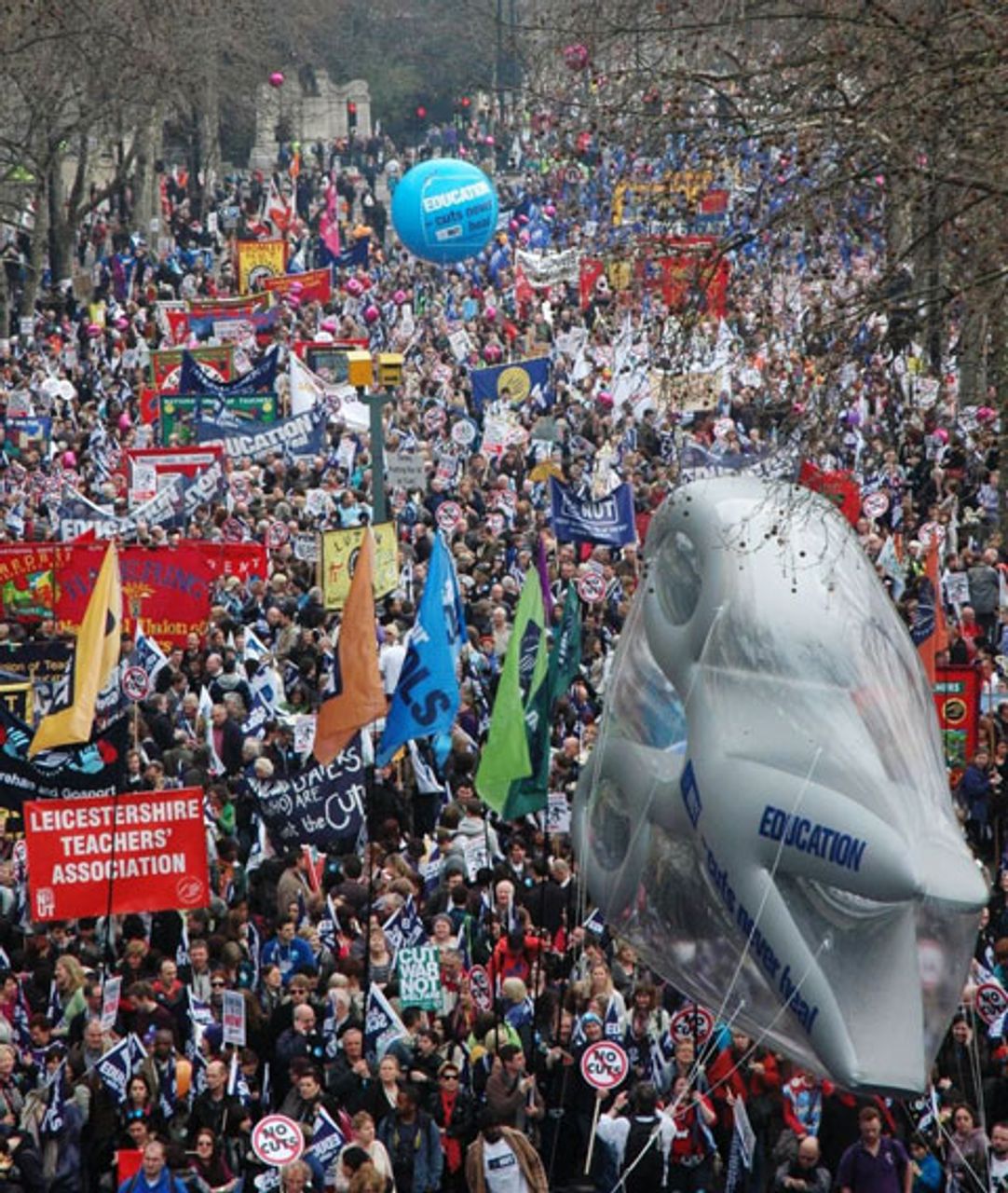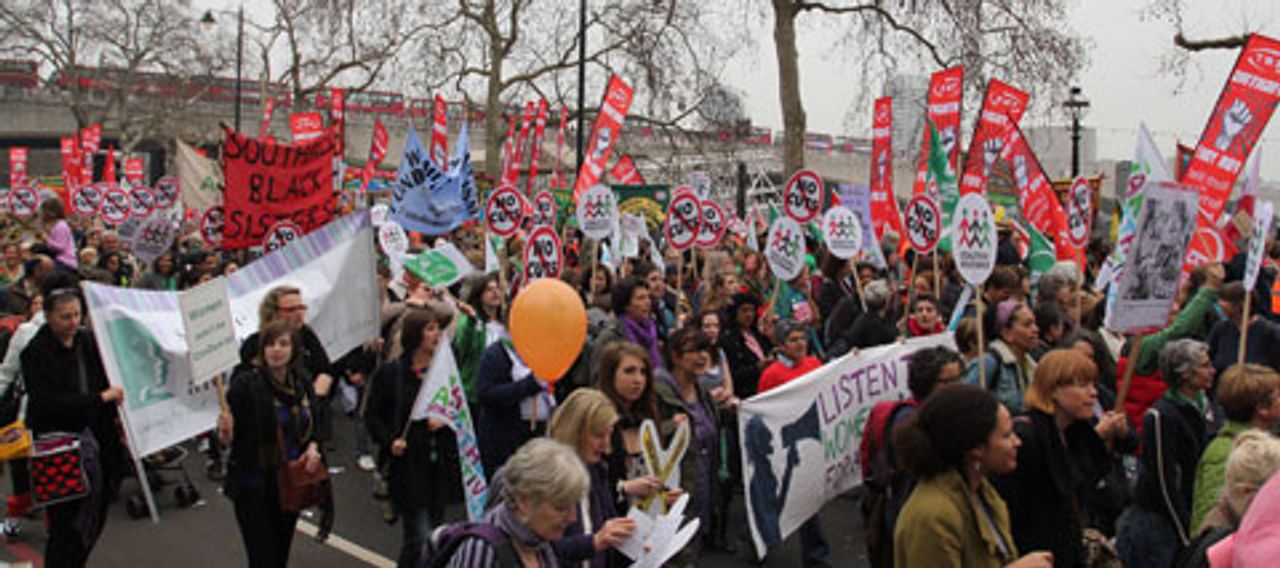 A section of the TUC march as it left the Embankment
A section of the TUC march as it left the EmbankmentOn Saturday, up to half a million people took part in the London demonstration to protest against the Conservative-Liberal Democrat government’s austerity measures—the largest since the 2003 demonstration against the Iraq war and the second largest political protest in British history.
The demonstration was even more remarkable, given that the Trades Union Congress (TUC) and the union bureaucracy had restricted the mobilisation to the public sector. It is a sign of enormous pent-up anger that has been sat on by the trade unions since the coalition came to power last May.
The size of the demonstration far exceeded the expectations of the TUC, which downplayed the numbers involved to below those of the police, who notoriously underestimate figures.
The huge demonstration snaked its way across the capital—from the Embankment, past the Houses of Parliament, along Piccadilly to Hyde Park. Feeder marches from other starting points outside the city joined it along the route, one of which pulled a giant model of a Trojan horse. It took some people more than three hours to walk the three-mile route, with marchers still arriving in the park long after the official rally had closed.
 A section of the march
A section of the marchWhite, black and Asian people were present, including every generation, accent, a host of nationalities and varied social backgrounds. It was difficult to assess how many private sector workers were there, as the union banners were predominantly from the public sector—with large contingents of teachers, health care workers, council employees and firefighters. Hundreds of people in wheelchairs were at the front of the march, blowing whistles and carrying banners, some of which called for a general strike.
For a significant proportion of people, it was their first-ever protest. Most noticeable were the large numbers of young people—teenagers, students and young workers made up a sizeable contingent, some of whom had already taken part in last year’s protests against student fee rises and the end of the Educational Maintenance Allowance.
The demonstration was good-natured, with thousands of homemade banners. Police reported that around 150 protesters, unconnected with the main march, had taken to smashing windows of high-profile shops and hotels in Piccadilly, including the Ritz. But eyewitnesses said that the most violent confrontations were instigated by the police, who began kettling several thousand protesters gathered in Trafalgar Square and represented by disparate groups, including the Socialist Workers Party, anarchists and smaller protests groups.
Many people made their way to Socialist Equality Party members, calling out the slogans on the leaflet prepared for the day: “Reject the TUC’s ‘phoney war’, No cuts in public spending, No confidence in Labour and the unions, A socialist programme to fight the cuts, Build rank-and-file Committees to lead the struggle!”
Other people came for further discussion, pleased to see a real political alternative, after complaining about the official speeches, which reeled off lists of cuts, but offered no solution or a way forward.
The measure of the TUC’s real intentions in finally organising a demonstration was the pride of place on the platform afforded to Labour Party leader Ed Miliband. Amid his rhetorical invocations of the suffragettes, the civil rights movement and the anti-apartheid struggle in South Africa, Miliband stressed, to boos in the crowd, “There is a need for difficult choices, and some cuts”.
“We are here today from all walks of life, all classes, all backgrounds,” Miliband claimed, in order to conceal the overwhelmingly working class composition of the protest.
His emphasis on the need for “some cuts” was concealed behind militant-sounding speeches from whatever figures within the trade unions still have a vestigial claim to be “left wing”, including Unison General Secretary Dave Prentis, and Public and Commercial Services union General Secretary Mark Serwotka, who declared, “Strike together to let the government know we won’t accept it”—a refrain he has been spouting for years, but doing everything to prevent.
Unite General Secretary Len McCluskey declared ridiculously, “I have a message to the Labour Party. We need strong opposition. We need you on the barricades with us now… This is only the start. We need a plan of resistance including coordinated strike action.”
No such coordinated plan of strike action can be expected, let alone a manning of barricades. The TUC will work with the Labour Party to suppress the class struggle, as it has done for the past 10 months of the coalition and for 13 years while Labour was in office.
The demand from the media following the demonstration was unanimous. Having allowed workers to let off steam on their “March for an Alternative”, the Labour Party and the TUC must now be tasked with telling workers that there is in fact no alternative to cuts and austerity.
The liberal pro-Labour press was indistinguishable from its pro-Tory counterparts.
The Observer, the Sunday edition of the Guardian, editorialised, “Protest is fine. Now for a proper debate”:
“Even in the most straitened circumstances, there is always a range of options: who is taxed, who is spared, which departments’ budgets are protected, which are not. In that sense, the marchers have self-evident truth on their side… But there is also an important truth in [Conservative chancellor] Osborne’s position… there is no serious dispute about the need to bring the deficit down, only about the best timetable.”
“Labour is being pushed into a stance of perpetual carping,” it warned. “Ed Miliband is right to tap into anxiety that deficit reduction is happening too fast. But that view contains the tacit recognition that it must still happen at some stage.”
The Independent led with the observation, “It is in the nature of protest marches that they tend to be a reaction to decisions that have already been taken and are most unlikely to be reversed… There may be room for adjustment around the edges, but the basic plan has been decided and the alignment of forces behind it in the Commons is unlikely to shift over the next four years.”
Columnist John Rentoul even wrote of Miliband’s “fundamental error of judgement in agreeing to speak at yesterday’s TUC march.”
The fake left groups, for their part, proceeded as if the TUC and its affiliated unions were merely reluctant to take the next step in organising strike action against the government and could be persuaded to do so by a modicum of rank-and-file pressure.
The Socialist Workers Party stressed, “Now we need trade union leaders to use the spirit of the march to call hard-hitting action that can bring down the government… We need coordinated strikes—and we need a general strike.”
The Socialist Party took its usual “realistic stance”. Not for them the bringing down of governments: “It is clear that the government has no choice but to have a plan B in reserve,” it wrote. “In the face of mass outrage, the Tory/Liberal coalition has already shown that it is capable of retreat.”
To secure such a retreat means demands for a “24-hour public sector general strike.”
“A public sector general strike, even a partial one, would do even more to raise confidence and prepare the ground for an all-out 24-hour general strike,” it adds. “While local action and action by individual trade unions cannot be delayed until we get generalised strike action, there is no objective reason why trade union leaders cannot discuss together in order to set a date on which everyone plans to come out.”
For both groups, everything is left in the hands of the trade union leaderships in which their members, former members and allies occupy a prominent place.
In its statement, “Reject TUC’s phoney war”, the SEP opposed this call for prostration before the union tops and their Labour allies.
“The first step in opposing the austerity drive is a fight to bring down the government implementing it. Instead, the trade unions hold out the possibility that the Liberal Democrats can be persuaded to abandon the Tories and form a coalition with Labour,” we wrote.
“Everything depends on working people breaking from the Labour Party and trade unions and building new democratic organisations of working class struggle.”
Fill out the form to be contacted by someone from the WSWS in your area about getting involved.
